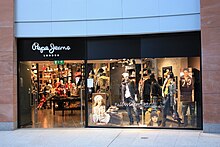
Fashion is a term used interchangeably to describe the creation of clothing, footwear, accessories, cosmetics, and jewellery of different cultural aesthetics and their mix and match into outfits that depict distinctive ways of dressing as signifiers of social status, self-expression, and group belonging. As a multifaceted term, fashion describes an industry, styles, aesthetics, and trends.
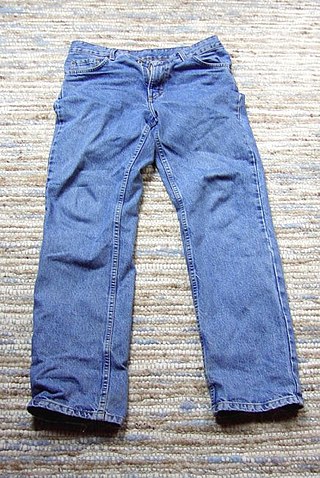
Jeans are a type of pants or trousers made from denim or dungaree cloth. Often the term "jeans" refers to a particular style of trousers, called "blue jeans", with the addition of copper pocket rivets added by Jacob W. Davis in 1871 and patented by Davis and Levi Strauss on May 20, 1873. Prior to the patent, the term "blue jeans" had been long in use for various garments, constructed from blue-colored denim.
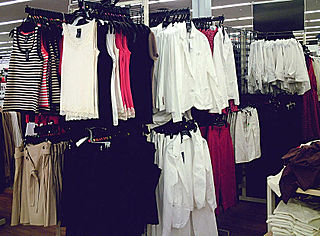
Ready-to-wear (RTW) – also called prêt-à-porter, or off-the-rack or off-the-peg in casual use – is the term for garments sold in finished condition in standardized sizes, as distinct from made-to-measure or bespoke clothing tailored to a particular person's frame. In other words, it is a piece of clothing that was mass produced in different sizes and sold that way instead of it being designed and sewn for one person. The term off-the-peg is sometimes used for items other than clothing, such as handbags. It is the opposite of haute couture.

Thigh-high boots, known also as thigh-length boots or simply thigh boots, are boots that extend above the knees to at least mid-thigh. Other terms for this footwear include over-the-knee boots, a name originally used for 15th century riding boots for men. These are sometimes called pirate boots, especially when cuffed. Over-the-knee boots are sometimes abbreviated to OTK boots. Lengths vary from reaching just over the knee to reaching almost to the crotch.

Chanel is a French luxury fashion house founded in 1910 by Coco Chanel in Paris. It is privately owned by the Wertheimer family and has been headquartered in London since 2018.

Jordache Enterprises, Inc. is an American clothing company that markets apparel, including shirts, jeans, and outerwear. The brand is known for its designer jeans that were popular in the late 1970s and early 1980s. Since the 2000s, Jordache has also diversified into real estate in the United States and other ventures in Israel. The brand name Jordache is a contraction of Joe, Ralph, David, and Avi Naccache (Nakash).

7 For All Mankind is an American denim brand founded by Michael Glasser, Peter Koral, and Jerome Dahan in 2000 and headquartered in Vernon, California. It was purchased by the VF Corporation in 2007 and sold to Delta Galil Industries in 2016.
Alfred Sung is a Canadian fashion designer and businessman. He is well known for producing apparel, fragrance, accessories and home fashions for women and men. He was born in Shanghai and raised in Hong Kong. Sung is the brother of late Hong Kong actress Lydia Shum. He is also a founder of Club Monaco, a mid-priced, high-end casual clothing retailer.

The term designer label refers to clothing, luxury automobile manufacturers and other personal accessory items sold under an often prestigious marque which is commonly named after a designer, founder, or a location-like where the company was founded. The term is most often applied to luxury goods. While members of the upper middle class, or the mass affluent, are perhaps the most commonly targeted customers of these designer labels, some marquees—such as Cartier, Rolex, Montblanc and the haute couture — tend to a wealthier customer base. But almost every designer brand has merchandise that the middle-class wouldn't normally be able to afford, such as exotic skins, furs and hides, limited edition pieces, or things simply priced higher. Designer label companies use their smaller and cheaper merchandise, aimed at the middle class, such as wallets, fashion jewellery, key-rings and small accessories, to make the majority of their income, whilst the more expensive pieces such as haute couture, high jewellery, hand-bags, shoes and even furnishings are usually reserved for the wealthier upper-class clientele.
"Fashion victim" is a term claimed to have been coined by Oscar de la Renta that is used to identify a person who is unable to identify commonly recognized boundaries of style.

Fashion design is the art of applying design, aesthetics, clothing construction and natural beauty to clothing and its accessories. It is influenced by culture and different trends, and has varied over time and place. "A fashion designer creates clothing, including dresses, suits, pants, and skirts, and accessories like shoes and handbags, for consumers. He or she can specialize in clothing, accessory, or jewelry design, or may work in more than one of these areas."
The Great Western Garment Company (GWG) was a Canadian denim and western wear clothing company founded in 1911 in Edmonton, Alberta by Charles A. Graham and Alexander Cameron Rutherford, the first Premier of Alberta. The company was acquired by Levi Strauss, starting in 1961.
A cruise collection or resort collection or resort wear sometimes also holiday or travel collection, is an inter-season or pre-season line of ready-to-wear clothing produced by a fashion house or fashion brand in addition to the recurrent biannual seasonal collections — spring/summer and autumn /winter — heralded at the fashion shows in New York, London, Paris, and Milan.
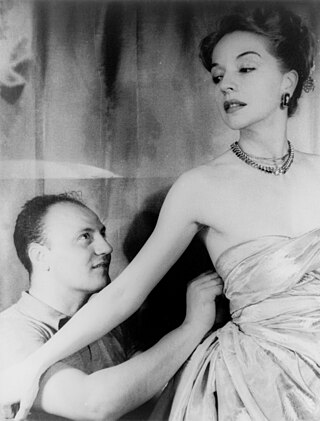
Haute couture is the creation of exclusive custom-fitted high-end fashion design. The term haute couture is French, "haute" meaning "high" or "elegant," and "couture" translating to "sewing" or "dressmaking." The term haute couture generally refers to a specific type of upper garment common in Europe during the 16th to the 18th century, or to the upper portion of a modern dress to distinguish it from the skirt and sleeves. Beginning in the mid-nineteenth century, Paris became the centre of a growing industry that focused on making outfits from high-quality, expensive, often unusual fabric and sewn with extreme attention to detail and finished by the most experienced and capable of sewers—often using time-consuming, hand-executed techniques. Couture translates literally from French as "dressmaking", sewing, or needlework and is also used as a common abbreviation of haute couture and can often refer to the same thing in spirit.
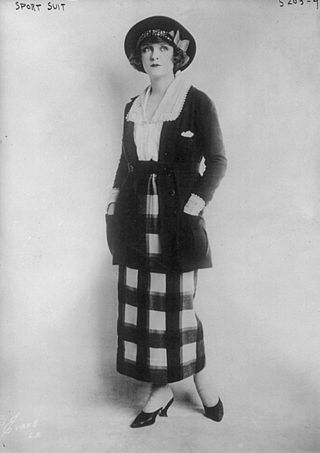
Sportswear is an American fashion term originally used to describe separates, but which since the 1930s has come to be applied to day and evening fashions of varying degrees of formality that demonstrate a specific relaxed approach to their design, while remaining appropriate for a wide range of social occasions. The term is not necessarily synonymous with activewear, clothing designed specifically for participants in sporting pursuits. Although sports clothing was available from European haute couture houses and "sporty" garments were increasingly worn as everyday or informal wear, the early American sportswear designers were associated with ready-to-wear manufacturers. While most fashions in America in the early 20th century were directly copied from, or influenced heavily by Paris, American sportswear became a home-grown exception to this rule, and could be described as the American Look. Sportswear was designed to be easy to look after, with accessible fastenings that enabled a modern emancipated woman to dress herself without a maid's assistance.
Frank Mechaly in Marseille, France and raised in St. Tropez, is a jeans designer and brand maker, specializing in premium denim. Though he has successfully launched a number of brands including Sacred Blue and Blue Cult, he is probably best known as the founder and creator of 575 DENIM which has been embraced by celebrities such as Cameron Diaz who made a point of publicly acknowledging her affinity for the jeans during an appearance on Saturday Night Live. Mechaly has now launched his much-anticipated new brand of premium denim called RockStar.
True Religion Brand Jeans is an American clothing company established in 2002 by Jeff Lubell and Kym Gold and is based in Vernon, California.

Tilmann Wröbel is a Franco-German fashion designer born in 1964 in Düsseldorf, Germany. He is currently working and living in both Biarritz, France and Düsseldorf, Germany.
DSTLD is an American clothing company, founded in 2014 by Corey Epstein, Ryan Jaleh and Mark Lynn and backed by Asher New York Holdings. The California-based company designs and retails a line of mostly denim-based clothing. The company has become known for its relatively affordable pricing, environmentally friendly design and manufacturing, a direct-to-consumer retail strategy.
The term "fashion brand" includes all the brands that operate within the fashion industry. A fashion brand combines symbolism, style, and experiential elements, and it needs to differentiate its products and coordinate its supply chain to succeed in the market. Consumers commonly employ brands as a means of expressing either their genuine identity or an idealized self-image that they aspire to achieve.




